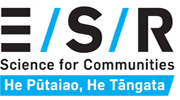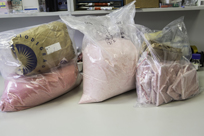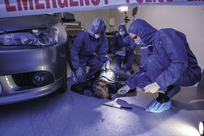Drug types commonly identified by ESR include cannabinoids (such as marijuana, hashish, hash oil and synthetic cannabis), amphetamine type substances (such as methamphetamine (meth, P, speed), MDMA (ecstasy) and MDA), opiates (such as heroin, morphine and codeine), cocaine, LSD, gamma-butyrolactone (GBL)/gamma-hydroxybutyric acid (GHB) and benzodiazepines (such as valium, rivotril and clonazepam).
About clandestine laboratories
A clandestine laboratory or ‘clan lab’ is a place where illegal substances including drugs, explosives, biological or chemical weapons are manufactured or prepared. Clan labs producing cannabis oil, homebake heroin, GBL, methamphetamine and other amphetamine-type substances have been known to operate in New Zealand.
Some of the labs, such as those producing cannabis oil, utilise simple extraction procedures whereas those manufacturing drugs such as methamphetamine are more complex, requiring a number of different chemicals, equipment and manufacturing processes.
In New Zealand the most common drug being manufactured is methamphetamine, using ephedrine or pseudoephedrine as the starting material.
Clan labs manufacturing methamphetamine can range from basic operations using homemade and/or common household equipment to more sophisticated operations using traditional laboratory equipment and glassware. The labs in New Zealand are usually portable and have been located in private residential dwellings, apartments, commercial premises, motel and hotel rooms, caravans, vehicles and boats.
Tell-tale signs of the manufacture of methamphetamine
In the past, a common sign that the manufacture of methamphetamine could be taking place at an address was the presence of empty pseudoephedrine associated cold and flu packaging, drain cleaner and solvent bottles in the rubbish and the presence of a two-layered liquid waste.
Currently the most common precursor being observed in New Zealand is ephedrine hydrochloride which requires no solvent extraction process. Most (if not all) methamphetamine labs in New Zealand have stopped using solvents. This combined with the use of a closed reaction vessel during the manufacture of methamphetamine has meant labs in New Zealand are now almost odourless and tell-tale signs far less obvious.
The impact of new techniques means that clan methamphetamine labs are now more difficult to detect. They are more portable, almost odourless and produce less waste. Mostly they are relatively silent, with no glassware to break and no machinery to run. Gone are the days when neighbours might report strange smells and noises coming from next door’s garage.
Methamphetamine contamination during manufacture
Contamination of the surrounding area can occur during the manufacture of methamphetamine. It may arise, for example, from accidental spillage, boil-over from an uncontrolled reaction, aerosol fumes or evaporation of solvents. Contamination often includes residues of methamphetamine and/or chemicals such as iodine. It is thought that methamphetamine is released as an aerosol during the manufacturing process.
The method of manufacture, the type of equipment used and the number of times manufacture takes place will determine the extent of contamination within a property.
Contamination through methamphetamine use
Contamination of the surrounding area can also occur during the use, such as smoking, of methamphetamine. The contamination caused by methamphetamine use alone is less hazardous than the contamination present from a manufacturing process, as the chemicals used for manufacture are not present.
How is contamination detected?
Methamphetamine sampling is used to determine which areas of a property are contaminated and require remediation.
Methamphetamine contamination is not visible to the naked eye and is detected through surface testing. A methanol dampened swab is taken from a surface and analysed in a laboratory using analytical techniques such as liquid chromatography with tandem mass spectrometry or gas chromatography with mass spectrometry. Contamination levels are reported as µg/100cm2. A microgram (µg) is one millionth of a gram (g).
Ministry of Health Guidelines for the remediation of clan labs
Guidelines for the Remediation of Clandestine Methamphetamine Laboratory Sites were published by the New Zealand Ministry of Health in 2010. When determining appropriate levels for these guidelines, the Ministry of Health looked at those developed by various states in the United States of America (USA) and Australia.
While the health effects of exposure to chemicals used in the manufacture of methamphetamine are known, the chronic health effects from living in a contaminated property are less clear as only a limited amount of research has been conducted so far. It is a public health issue as there is an unknown number of potentially contaminated properties.
In the Ministry of Health’s ‘Guideline for the Remediation of Clandestine Laboratory Sites’ the Ministry recommended a methamphetamine concentration of 0.5μg/100cm2 as the acceptable post-remediation re-occupancy level for a dwelling that has been used as a methamphetamine lab.
The Ministry of Health’s document makes no reference to contamination caused by methamphetamine use (smoking) and there has inevitably been issues (mainly concerning insurance claims) in determining whether a site was a clan lab or whether the contamination was simply down to methamphetamine use. Introduction and the Development of NZS 8510:2017
This year a new ‘Standard methamphetamine (NZS 8510:2017) was issued and states that the acceptable post-remediation re-occupancy level for a dwelling (regardless of the source of the contamination) is 1.5µg/100cm2.
Although the new standard has imposed some strict rules around the sampling and testing process which will subsequently inform an independent remediation strategy, there is little information available that explains the activity that has taken place to cause the contamination. The lack of detail may still be an issue for the loss adjustment/claims process. Public demand for understanding what these ‘levels’ mean and the nature and causes of the contamination is apparent, mainly because it useful to our decision making processes in ensuring (or insuring) that it doesn’t happen again.
Nevertheless, the introduction of the Standard along with the formation of the Methamphetamine Testing Industry Association New Zealand (MTIANZ)(external link) means the New Zealand public can be more confident in the testing and remediation process.

Drugs in wastewater project
This project combines two of ESR’s expert capabilities in drug forensics and biowaste


